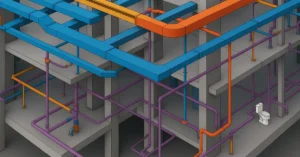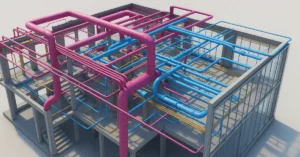In the heart of every bustling metropolis, towering skyscrapers define the modern cityscape, reaching for the heavens as symbols of architectural marvels and human ambition. These magnificent structures, often touching the clouds, are more than just engineering achievements; they’re testaments to the fusion of artistic vision, technological innovation, and urban necessity. Welcome to the captivating realm of skyscraper design, where architecture soars to new heights and reshapes the urban horizon.

Unveiling the Artistry and Engineering Behind Modern Skyscraper Design
Defining Skyscrapers:
Skyscrapers are towering structures characterized by their significant height and multiple levels. While the exact height threshold might vary by region or context, a building is generally considered a skyscraper when it significantly exceeds the average height of surrounding buildings. Initially, these structures emerged in response to the scarcity of available land in densely populated urban areas. As cities grew, architects and engineers found ingenious ways to build upwards, defying gravity and conventional design limits.
Historical Evolution:
The story of skyscraper design is a fascinating journey through time. It began in the late 19th century with the construction of the Home Insurance Building in Chicago, widely regarded as the first skyscraper. Designed by William Le Baron Jenney, this 10-story structure introduced the concept of a steel frame that could support the building’s weight, allowing for greater height and stability. This innovation laid the groundwork for the skyscrapers that would follow.
Architectural Marvels:
Skyscrapers are not only engineering feats but also architectural wonders that push creative boundaries. From the iconic Empire State Building in New York City to the breathtaking Burj Khalifa in Dubai, each skyscraper tells a unique story through its design. Architects incorporate elements of style, functionality, and cultural identity, shaping buildings that become synonymous with their cities. The sleek glass façade of the Petronas Towers in Kuala Lumpur or the futuristic curves of The Shard in London are all part of the intricate language of skyscraper design.
Structural Ingenuity:
The fundamental challenge of skyscraper design lies in creating structures that can withstand the forces of wind, gravity, and even earthquakes. Engineers employ cutting-edge technologies such as tuned mass dampers, which are massive weights that sway in the opposite direction of the building’s movement, counteracting vibrations and maintaining stability. Advanced materials like reinforced concrete and high-strength steel play crucial roles in providing the necessary strength without excessive weight.
Sustainable Skyscrapers:
In an era of increasing environmental consciousness, skyscraper design has taken a green turn. Sustainability is now a driving force behind many modern skyscrapers. Architects and engineers strive to reduce energy consumption, utilize renewable materials, and incorporate green spaces within the vertical landscape. The Bosco Verticale in Milan exemplifies this trend, with its terraces covered in lush vegetation that not only enhance the building’s aesthetics but also contribute to air purification and biodiversity.
The Future Skyline:
As technology continues to advance, the future of skyscraper design holds exciting possibilities. Concepts like rotating buildings, vertical cities, and self-sustaining ecosystems within skyscrapers are no longer confined to science fiction. With the advent of 3D printing and smart materials, architects can explore new realms of creativity while addressing urban challenges. As cities grow more interconnected, skyscrapers might become not only centers of commerce and residence but also hubs of transportation and energy innovation.
Conclusion:
The world of skyscraper design is a captivating fusion of engineering, artistry, and human aspiration. From the historic origins of the Home Insurance Building to the soaring heights of today’s architectural marvels, skyscrapers stand as testaments to our ability to transcend physical limits and reshape the urban landscape. As we gaze upward at these towering giants, we are reminded that the sky is not the limit—it’s just the beginning. So, join us as we embark on a journey through the intricacies and wonders of skyscraper design, where innovation and imagination reach unparalleled heights.
For more SketchUp tutorials you can check out https://www.sketchupguru.com/blog/
You can also check more tutorial videos for sketchup on our YouTube Channel,
https://www.youtube.com/c/SketchupGuru
To know about the Top Online 3D Rendering Courses for 2022 click,










